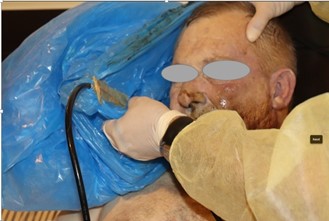Volume 4, Issue 4
April 2024
Suicidal Death Due to Helium Inhalation: A Case Report
Abdullah M. Al Dossary, Mohamed S. Abdelrahman, Meshari A. Almutairi, Ahmed N. Alshammari, Bayan A. AlMusailhi, Yara N. Al Anazi
DOI: http://dx.doi.org/10.52533/JOHS.2024.40405
Keywords: suicide, helium inhalation, citalopram, suffocation
Helium inhalation has been used as a method of suicide due to its rapid onset and perceived painlessness. However, little is known about the specific circumstances and forensic aspects surrounding helium-induced deaths, particularly when combined with other substances such as alcohol and antidepressants. We report a case of an adult male who was found deceased in his home, with evidence suggesting helium inhalation as the cause of death. Toxicological analysis also revealed the presence of ethyl alcohol and the antidepressant Citalopram in various body tissues. The combination of these substances raises questions about their potential contribution to the fatal outcome. This case highlights the importance of thorough forensic investigations in cases of unusual or unexpected deaths, particularly when multiple substances are involved. Understanding the interactions between these substances and their effects on the body is crucial for accurate cause of death determination and prevention strategies.
Introduction
Helium inhalation as a method of suicide is a rare but potentially lethal practice. Helium, an inert gas, displaces oxygen in the lungs, leading to asphyxiation without the usual signs of struggle or trauma. While helium-related suicides are uncommon, they present unique challenges for forensic investigation due to the difficulty in detecting helium in the body and the need for meticulous scene examination. This case report presents a detailed analysis of a suicide case involving helium inhalation, highlighting the forensic aspects and challenges associated with such incidents.
Helium inhalation has been documented in the literature as a method of suicide, with several cases reported in forensic and medical journals. In a study by Tominaga et al., helium inhalation was identified as the cause of death in a series of suicide cases, underscoring the importance of recognizing and understanding this method in forensic practice (1). Similarly, a case report by Carfora et al. described a suicide involving helium inhalation, highlighting the difficulties in detecting helium in post-mortem examinations (2).
Forensic investigations of helium-related deaths require a comprehensive approach, including a thorough examination of the scene, toxicological analysis, and understanding the victim's mental health history (3, 4). The positioning of the body and any associated items, such as the helium cylinder and bags, must be carefully documented to reconstruct the sequence of events leading to death accurately. Toxicological analysis is crucial to confirm the presence of helium and rule out other possible causes of death (5).
Helium inhalation as a method of suicide is not limited to a specific demographic or geographic region (6). Cases have been reported in various countries around the world, indicating the global prevalence of this method. However, due to its rarity, there is limited research on helium-related suicides, and more studies are needed to understand the factors contributing to this method and its implications for forensic practice (7, 8).
Helium inhalation is a rare but potentially lethal method of suicide that presents unique challenges for forensic investigation. Understanding the complexities of helium inhalation as a method of suicide is essential for forensic practitioners to accurately determine the cause of death and provide closure to families and loved ones affected by such incidents. Here, we present a case of an adult male who died from helium inhalation, with additional findings of alcohol and antidepressants in his system.
Case Report
A 59-year-old male was found sitting on his bed, with his back against the headboard facing the TV, which was on. The air conditioner was running at 16 degrees Celsius. He was wearing cotton shorts and was bare-chested. Four plastic bags, light blue in color, were tightly wrapped around the head and face (Figure 1), secured around the neck with a black fabric adhesive strap. A thin black hose, approximately 1 meter long, was inserted into the bags, with its end inside the bags at the level of the nose, secured from the inside with brown adhesive (Figure 2). The other end of the hose was connected to a helium gas cylinder, with the open end held in the deceased's left hand.

Figure 1: The body with the plastic bags wrapped around face and head.

Figure 2: Hose fixed inside the bags at the level of nose.
The body’s back complete rigor mortis, with blood pooling present on the back of the body, except in areas of contact, more prominently seen in the lower part of the body and the back. The color was light purple, with the beginning of small bubbles indicating skin decomposition. No external injuries suggestive of violence or struggle were observed, with bloody secretions coming from the nose and mouth after removing the plastic bags from around the head and face. Cyanotic discoloration was observed in the nails, lips, and some facial swelling.
A small helium gas cylinder (brand: BALLOONEE) was found inside its carton, placed on the left side of the deceased. Upon examination, the hose was disconnected from the cylinder, with its free end held in the deceased's left hand. The cylinder valve was open and empty. Another similar helium gas cylinder, full and inside its cover, was found next to the right side of the bed. A collection of balloons of different colors was placed on the nearby bedside table. Trace amounts of ethyl alcohol were detected in the toxicology report, likely post-mortem formation. Additionally, the presence of Citalopram, an antidepressant, was detected in various body tissues, but it alone was insufficient to cause death.
Toxicological analysis revealed trace amounts of ethyl alcohol in the liver (44 mg/100g), kidney (27 mg/100g), stomach contents (34 mg/100g), and lung (31 mg/100g) samples. Additionally, the presence of Citalopram was detected in the blood (1262 ng/ml), urine (1235 ng/ml), liver (136 ng/g), kidney (1415 ng/g), stomach contents (360 ng/g), lung (2664 ng/g), and brain (584 ng/g) samples. The presence of ethyl alcohol in various body tissues is consistent with post-mortem formation rather than antemortem consumption. The detection of Citalopram, an antidepressant, in high concentrations in multiple tissues raises questions about its potential role in the death. However, the toxicological findings alone do not provide sufficient evidence to determine the cause of death definitively. Helium inhalation remains the most likely cause, as indicated by the circumstances surrounding the discovery of the body and the autopsy findings. This case illustrates the complexities involved in determining the cause of death in cases involving multiple substances. The findings highlight the need for comprehensive forensic investigations to accurately assess the contribution of each substance to the fatal outcome. Understanding the interactions between substances and their effects on the body is essential for effective prevention strategies and post-mortem investigations.
Discussion
Helium inhalation as a method of suicide presents unique challenges for forensic investigation, as demonstrated in this case. The rapid onset and perceived painlessness of helium asphyxiation make it an attractive method for suicide, particularly when combined with other substances such as alcohol and antidepressants. The unique circumstances surrounding the death of a 59-year-old male, found with helium delivery apparatus in place, underscore the complexities of forensic investigations in potential suicide cases. The meticulous setup involving helium gas—a method documented in the literature for its rapid induction of unconsciousness and hypoxia—suggests a deliberate act. Helium, being a non-toxic, inert gas, displaces oxygen in the respiratory system, leading to hypoxic death without the struggle typically associated with asphyxiation (9). The deceased was found with plastic bags tightly wrapped around his head and face, connected to a helium gas cylinder. The presence of rigor mortis, post-mortem lividity, and early signs of decomposition provide a timeline consistent with death occurring several hours prior to discovery.
Importantly, the lack of external injuries or signs of struggle corroborates a self-administered cause rather than homicide.
Toxicological tests identified the presence of ethyl alcohol and the antidepressant Citalopram in numerous body tissues. The detection of ethyl alcohol in these tissues is more indicative of formation after death rather than consumption prior to death. Conversely, the presence of Citalopram in elevated levels across various tissues, notably in the brain, prompts consideration of its role in the death. Known side effects of Citalopram include dizziness, confusion, and impaired judgment, which might heighten the likelihood of self-harm or intensify the impact of helium inhalation. Additionally, this case is further complicated by the substantial levels of Citalopram found, a drug linked to an increased risk of suicidal thoughts, especially during the initial stages of treatment (10). Although toxicological analysis suggests the levels of Citalopram were insufficient to cause death directly, its role in potentially influencing the decedent's mental state cannot be overlooked. The trace amounts of ethyl alcohol detected are considered artifacts of post-mortem biochemical processes, thus not contributing to death but indicating a post-mortem interval that aligns with the observed physical decomposition (1, 9). The combination of these findings necessitates a nuanced interpretation, focusing not just on the mechanical aspects of helium inhalation but also on the psychiatric and toxicological context that could have led to the decision of self-harm.
Forensic investigations of helium-related deaths require a comprehensive approach, including a thorough examination of the scene, toxicological analysis, and understanding the victim's mental health history. The positioning of the body and any associated items must be carefully documented to reconstruct the sequence of events accurately. Toxicological analysis is crucial to confirm the presence of helium and rule out other possible causes of death.
Conclusion
This case highlights the importance of thorough forensic investigations in cases of unusual or unexpected deaths, particularly when multiple substances are involved. Understanding the interactions between these substances and their effects on the body is crucial for accurate cause of death determination and prevention strategies. Helium inhalation remains a rare but potentially lethal method of suicide, and more research is needed to understand its prevalence and implications for forensic practice.
Disclosure
Conflict of interest
There is no conflict of interest
Funding
No funding
Ethical consideration
The institutional review board of Riyadh Forensic Medical Services granted permission to publish this report for the scientific value of the case.
Data availability
Data that support the findings of this study are embedded within the manuscript.
Author contribution
All authors contributed to conceptualizing, clinical data drafting, diagnosis, treatment and final writing of the manuscript.
